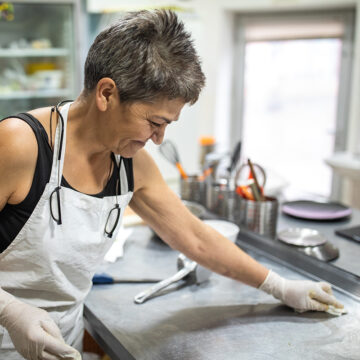Vocational training is a core part of Raleigh Rescue Mission. When a client enrolls in the New Life Plan and moves into the Mission, they’re given a specific assignment on campus that helps them get back in the habit or stay in the habit of working. A staff member oversees each job – i.e. chefs supervise the kitchen staff – and coaches the client throughout their first few months in the New Life Plan.
Below, we explain the purpose of vocational training, how it works, and how it benefits the men and women in the New Life Plan.
Every client at Raleigh Rescue Mission participates in vocational training. It’s required of each client in the New Life Plan, as it’s a back-to-work program.
Vocational training, or “VT,” serves many purposes, but ultimately, it’s to help a client succeed in the workplace.
“We use VT as a tool to get our clients back in the mindset of working productively for 10-12 hours a day,” explains Twanda Hall, Client Learning and Development Program Manager.
Vocational training also helps staff identify areas where a client might need assistance.
“Let’s say they can’t get to VT on time,” said Twanda. “Eventually, if you get a job and can’t be on time, you’re going to lose your job.”
Other examples could be how a client handles conflict or works together with people. Vocational training creates a space and the time to work on any areas that need improvement.
It also gives the clients something to do outside of their daily classes and keeps their mind busy. “There’s no sitting around at Raleigh Rescue Mission!” said Twanda.
A few examples of vocational training at the Mission include:
A lot of thought goes into what job a client is assigned. Twanda and Bob Peterlin, Client Learning and Development Facilitator, meet with the clients within their first few days of arrival at the Mission for a VT meeting. They’ll hear about the client’s work history, their interests, and any limitations that need to be considered, like if they’re not able to lift or stand for a long time.
“It can also be based on their personality,” said Twanda. “It can go two ways. If a person is standoff-ish, I might place them somewhere they can face those fears but not somewhere that could cause them to give up. You have to find that balance. We don’t want to hurt you, but we want to help you in that process.”
A vocational training is assigned in the first couple of days upon entering the Mission and will continue until the client is employed outside of the Mission, which is a minimum of three months.
Clients aren’t employed until after Jobs for Life graduation, which is Phase 3 in the New Life Plan. If they graduate from Jobs for Life without a job, they continue their vocational training until they’re hired. If their employment ends for any reason, the client goes back to doing their vocational training while looking for a new job.
